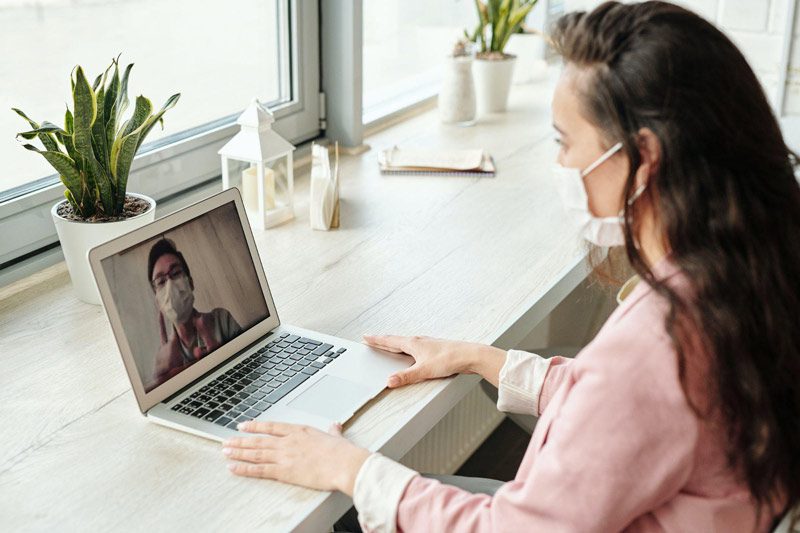Telehealth is an essential tool of the modern era—one boosted by Covid-19 and emerging technologies. In rural Michigan, the share of adults who used telehealth for remote monitoring or counseling rose from 10% to 17% in 2021. The rate of increase was even higher in 2020 when the U.S. Department of Health and Human Services (HHS) reported a 32-fold increase in Medicare telehealth services for behavioral health.
By exploring the pros and cons of telehealth for counseling patients, you can make better wellness decisions for you and your family. Here’s what you need to know about the impact of telehealth.
Telehealth Changes Counseling for Patients
Telehealth, broadly defined, is the range of healthcare services available to patients virtually. From a device as simple and accessible as a smartphone, individuals can participate in certain wellness services such as counseling through telehealth. This has immense implications for all kinds of users.
For instance, you no longer need to expose yourself to traffic, crowded waiting rooms, and the risk of catching COVID-19 if you opt for a virtual conversation with your counselor instead of the traditional face-to-face meeting. This changes what’s possible for patients, enabling safer care.
But the implications of telehealth on counseling patients aren’t necessarily all good. For instance, there’s a serious problem with internet connectivity in certain parts of the nation, especially in rural areas. The pivot to telehealth won’t serve those patients who have long struggled with accessible care.
However, the feedback from the millions of patients already using telehealth services is encouraging. One American Medical Association (AMA) survey found that 79% percent of patients were very satisfied with the care they received during their last telehealth visit. This is great news for the long-term viability of telehealth services. Telehealth isn’t going away, so the changes it creates for patients are particularly meaningful.
As an assistive technology, telehealth is filling gaps in patient care, much like how other assistive technologies help make care more equitable. On the other hand, the challenges of more screen time and isolation on patient mental health could be consequential.
There’s no doubt that telehealth creates a new reality for counseling patients. And, as with any change, it comes with pros and cons. By evaluating the benefits and drawbacks of telehealth for counseling patients, we can understand the landscape of future mental health care better.
The Benefits
Let’s start with the benefits of telehealth in counseling, of which there is no shortage. Patients like this service option for many reasons, ranging from its convenience to relatively lower costs. It can remove all kinds of barriers to mental health care that make receiving ongoing counseling difficult for patients.
For example, the role of telehealth and other technologies in addiction recovery has been critical throughout the pandemic. These platforms offer safe ways for patients to share their stories and check in with care providers. Meanwhile, an estimated 85% of adults already access care through mobile services, resulting in a more efficient distribution of services that improves access for everyone.
As patient care and technology merge in telehealth, other patient benefits will become astoundingly clear. By virtue of their digital connectivity, telehealth services are great at collecting and parsing patient data. This means more access to insights for care providers that can translate to better care. Evolving deep data analytics can now do everything from diagnosing certain conditions to evaluating text language for suicidal risk indicators.
In short, the benefits of telehealth for counseling patients entail the following:
- Greater accessibility
- Lower costs
- Enhanced care solutions
However, these benefits don’t negate the drawbacks some patients experience from telehealth counseling. This option isn’t for everyone, and it’s important to understand why.
The Drawbacks
While you may not think of telehealth as having its own set of risks and challenges, this service comes with trade-offs. While patients gain convenience, they also assume cybersecurity and health risks from a greater reliance on technology. Looking into the extent of these effects for you personally should be an essential part of your care decisions.
For instance, the modern world is plagued by cybersecurity threats, particularly in healthcare. Hackers target this vulnerable data because of its value on the black market, and attacks are rising. In 2020, nearly one million Americans were affected every month by healthcare-related data breaches, meaning data isn’t always safe with telehealth services.
Meanwhile, technology usage itself can create mental health challenges. For instance, in early childhood development, overuse of technology has been found to contribute to limited attention spans and declines in social skills. In-person counseling may still be preferable for patients struggling to pay attention online, such as young children.
Additionally, the prevalence of telehealth counseling does not benefit patients in areas where they cannot get good internet connections. The Federal Communications Commission (FCC) estimates that this includes 21 million Americans. The shift to tech-based services won’t translate to better care for these patients.
As telehealth increasingly becomes an option for counseling patients, these are some of the risks and challenges to consider:
- Vulnerability of personal data
- Communication challenges
- Greater reliance on technology
Consider these drawbacks in choosing your own health services. Counseling can be convenient with telehealth, but this option may not work for you.
A Future of Greater Care Solutions
All told, the future looks brighter because of the benefits telehealth offers counseling patients. While the cons include data risk and communication obstacles, the pros entail greater accessibility and enhanced treatments through data analytics. This means a future of expanded care solutions in mental health.
Every patient will have their own needs and preferences. Explore the impact of telehealth on counseling patients to understand better what treatments and services are right for you or your loved ones. These tips can help.
If you or someone you know experiences mental health issues, it is important to seek help from a qualified professional. Our Resource Specialist can help you find expert mental health resources to recover in your community. Contact us now for more information on this free service to our users.
About the Author: Dan Matthews is a writer, content consultant, and conservationist. While Dan writes on a variety of topics, he loves to focus on the topics that look inward on mankind and that help to make the surrounding world a better place to reside. When Dan isn’t working on new content, you can find him with a coffee cup in one hand and searching for new music with the other.
Resources to Recover and Our Sponsor Laurel House Celebrate Black History Month
February is Black History Month, a time for celebrating the outstanding achievements of Blacks and African Americans and their central role in US history. It is also a time to recognize the struggles Black people have faced throughout the history of our nation and give tribute to the strength and resilience of generations of Black Americans who have risen above adversity.
Black History Month originated from an idea by Harvard-educated historian Carter G. Woodson, who wrote the Journal of Negro History in 1916 to herald the achievements of overlooked African Americans in US history and culture. In 1926 he led an effort by the Association for the Study of Afro-American Life and History (ASALH) to officially declare the second week of February as “Negro History Week.” These dates align with the birthdays of two crucial figures in Black American history: Abraham Lincoln (February 12, 1809), who signed the Emancipation Proclamation officially ending slavery in the United States, and the Black American abolitionist and author Frederick Douglass (February 14, 1818), an escaped slave who is widely considered the most influential civil and human rights advocate of the 19th century. In 1976, President Gerald Ford gave official governmental recognition to the observance by declaring February “Black History Month.”
Without the contributions of Blacks and African Americans to more than 500 years of US history, culture, entertainment and the arts, science, athletics, industry and the economy, public service, and the Armed Forces, we would not be the country we are today.
Image Source: Pexels
The opinions and views expressed in any guest blog post do not necessarily reflect those of www.rtor.org or its sponsor, Laurel House, Inc. The author and www.rtor.org have no affiliations with any products or services mentioned in the article or linked to therein. Guest Authors may have affiliations to products mentioned or linked to in their author bios.
Recommended for You
- Veterans and Addiction Recovery: How Families Can Support Their Service Member’s Healing Journey - July 14, 2025
- Trauma-Aware Yoga: A Gentle Path to Healing and Recovery - July 10, 2025
- Why Eating Disorders in Men Are Often Missed - July 3, 2025





